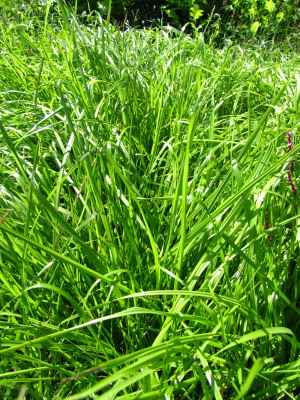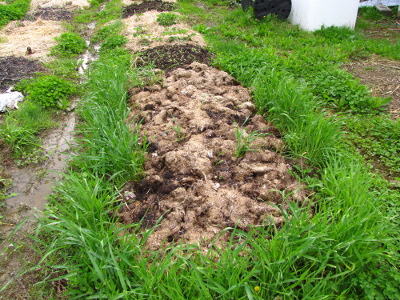
Annual ryegrass cover crop
 I'm
convinced that many different cover crops have a place in our
garden...I just haven't found them all yet. Currently, my old
standbys are fall-planted
oats and oilseed radishes for winter cover, then buckwheat
for short fallow periods in the summer garden. But I've found
another niche I want to fill, and I'm hopeful annual ryegrass will
slide right in.
I'm
convinced that many different cover crops have a place in our
garden...I just haven't found them all yet. Currently, my old
standbys are fall-planted
oats and oilseed radishes for winter cover, then buckwheat
for short fallow periods in the summer garden. But I've found
another niche I want to fill, and I'm hopeful annual ryegrass will
slide right in.
My back garden is nearly
as eroded
and waterlogged as the forest garden, which means that many
vegetables do poorly there. I've raised some of the beds up with
trucked in manure and topsoil, but there's never enough organic matter
to go around, so most of the beds are still sitting in water.
Since I'm moving my
tomatoes to the forest garden's raised beds this year, I have about
twenty beds that can sit fallow until this time next year. That
just happens to be how many waterlogged beds there are in the back
garden, so it seemed like a perfect opportunity to see how much a long
term cover crop could build up such a troubled spot.
Annual ryegrass won the
lottery for several reasons, but the real selling point of this
brilliant green grass is that it can handle floods. The cover
crop bible (Managing
Cover Crops Profitably)
notes that annual ryegrass produces more biomass than small grains in
wet soil, growing as much as 9,000 pounds of organic matter per acre if
you mow the ryegrass down to four inches several times through the
course of the year. In addition, ryegrass is a succulent forage
that's very tasty for animals, making me hope I can put a temporary
fence around the back garden and run some of our broilers there.
 Before you get too excited,
annual ryegrass has some major pitfalls for the no-till gardener.
Traditional farmers plow ryegrass into the soil just as it starts to
bloom, but I'll have to get more creative. When I tried out
annual ryegrass last year, it
was very tough to kill,
and I decided that if I ever used it again, I would have to commit to
laying down a kill mulch to get rid of the vibrant greenery. The
photo here shows a bed of ryegrass approximately 75% killed by mowing
the ryegrass close to the earth, adding an inch of manure, and then
laying down grass clippings for mulch.
Before you get too excited,
annual ryegrass has some major pitfalls for the no-till gardener.
Traditional farmers plow ryegrass into the soil just as it starts to
bloom, but I'll have to get more creative. When I tried out
annual ryegrass last year, it
was very tough to kill,
and I decided that if I ever used it again, I would have to commit to
laying down a kill mulch to get rid of the vibrant greenery. The
photo here shows a bed of ryegrass approximately 75% killed by mowing
the ryegrass close to the earth, adding an inch of manure, and then
laying down grass clippings for mulch.
The other potential
problem with annual ryegrass is its tendency to self-seed and turn into
a weed problem. I'm going to need to be vigilant and mow the beds
whenever seed heads begin to form, which shouldn't be a problem in our
small back garden. Maybe this is my incentive to finally buy a
scythe that fits my stature, then learn to use it?
Want more in-depth information? Browse through our books.
Or explore more posts by date or by subject.
About us: Anna Hess and Mark Hamilton spent over a decade living self-sufficiently in the mountains of Virginia before moving north to start over from scratch in the foothills of Ohio. They've experimented with permaculture, no-till gardening, trailersteading, home-based microbusinesses and much more, writing about their adventures in both blogs and books.
Want to be notified when new comments are posted on this page? Click on the RSS button after you add a comment to subscribe to the comment feed, or simply check the box beside "email replies to me" while writing your comment.

Like you, I have a swampy area in a small meadow, that I hope to turn into a forest garden over the next couple of years.
I plan on using hoogle culture to raise the beds above our winter water table and at the same time, give the planted garden a water source under the soil. But I am fortunate to have an abundance of fallen trees to fill in this area before making plant guilds around fruit/nut trees.
However, this spring I will be planting my 14" fig tree. With it I plan on planting a couple of stumps to add an underground water source for my fig as it is growing.
Love your weekend homesteader and have downloaded about 10 or them so far.
Keep on writing.
Maggie --- I'm glad you liked the new banner! I'm ashamed to say I didn't get around to putting it up there until we were nearly six months into year six....
Mona --- It sounds like you'll have great luck with your hugelkultur experiment! Just be sure to remember that soil near the buried trees will be low in nitrogen for a year or two unless you add a lot of compost. Thanks for reading the ebooks!
Emily --- This little plot would serve as a midday snack for pigs, so it wouldn't really even make sense to borrow them.
I'm also torn about the issue of pigs and no-till. I think that pigs aren't as bad as a rototiller (if done right), but are worse than a kill mulch.
Andrea --- Interesting comment, but I think we're on slightly different wavelengths. No cows here --- this is a small plot of garden perhaps 600 square feet in total size (counting the aisles.)
Also, I suspect you're thinking about rye, not annual ryegrass. Rye is a winter crop, but annual ryegrass is a bit more forgiving of heat (or so I've read.) Managing Cover Crops Profitably notes: "Some varieties tolerate heat fairly well and can persist for several years under sound grazing practices that allow the grass to reseed." Not that I plan to let it go to seed, but if the summer kills it, that wouldn't be so bad --- I could just put in some buckwheat and keep the organic matter growing!